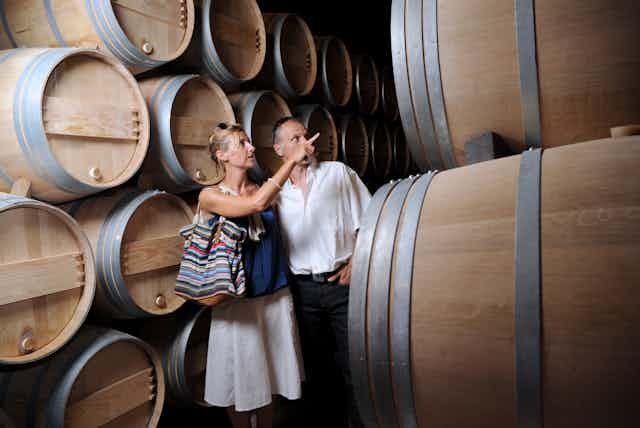In a non-COVID year, Australia’s vineyards host more than eight million wine tourists. While these visitors benefit wine producers and regional communities, they also generate a substantial amount of greenhouse gases.
If fact, our recent research showed tourist visits to vineyards comprise more than one-third of the industry’s total carbon footprint.
Wine tourism – also called “cellar door” visits – involves visiting vineyards, wineries, wine festivals and events to taste, drink and buy wine.
The Australian wine industry has already been forced to adapt to the effects of climate change. If it fails to curb emissions associated with wine tourism, the industry is contributing to its own demise.

Temperature change and ‘terroir’
In 2019, wine tourism contributed A$9.3 billion to the Australian economy – creating more jobs and economic output than any other part of the industry. It promotes exports and provides vital financial support for small winemakers and family farms that rely on cellar door sales to visitors.
When wine tourists aren’t in vineyards and tasting rooms, they often visit local restaurants, as well as cultural attractions such as museums, concerts and festivals.
Wine tourism gives travellers the chance to experience a region’s “terroir” – the particular geology, landscape, soil and climate that come together to make a region’s wine special.
Wine grapes however are particularly susceptible to temperature changes. In fact, the wine industry has been described as “the canary in the coal mine” for the way climate change will affect agriculture.
In Australia, winemakers have already been forced to adapt to heatwaves, drought, increased fire risk and salinity.
Previous research commissioned by Wine Australia has found global warming will bring many changes to the industry. For example, Australian winemakers may struggle to grow cool-climate varieties such as chardonnay and pinot noir.
Despite the industry’s vulnerability, the environmental sustainability of wine tourism is rarely addressed by either the industry or the academic literature. Our recent research sought to close this knowledge gap.
Read more: Tourism desperately wants a return to the 'old normal' but that would be a disaster

Our findings
Past research into the wine industry’s carbon footprint has examined factors such as the emissions created by shipping the wine in heavy glass bottles.
Our research examined wine tourism activities that create carbon emissions, such as those associated with transport, accommodation, food and shopping. We traced how much wine tourists spend on the journey and the energy required to produce those services. We then allocated a share of total emissions to cellar door visits.
We found Australian wine tourism generates 790,000 tonnes of greenhouse gas emisisons each year – one-third of the industry’s total carbon footprint. This translates to an average 101 kilograms of carbon emissions per winery trip, per person.
Domestic overnight wine tourists contributed the majority of environmental impacts (82%). However, due to their higher spending at wineries, their carbon emissions were lower than that of travellers from overseas when measured per dollar of spending.
We estimate one-quarter of wine tourists in Australia come from overseas, and long-haul flights form around 75% of international wine tourism’s carbon footprint.
Because of factors such as shorter flights, visitors from countries nearer to Australia – such as New Zealand, Hong Kong, China and Singapore – produce 20-40% fewer emissions per dollar spent than visitors from the United States and the United Kingdom.

Stock up at the cellar door
Given the emisisons associated with international wine tourism, Australian wineries should target visits by domestic tourists. This would benefit both the environment and regional economies starved of international visitors during the pandemic.
In terms of overseas travellers, the Australian wine industry should target short-haul markets such as China, Japan and Singapore. This would reduce the industry’s reliance on tourists travelling to Australia on emissions-intensive long-haul flights.
Many of us will be wine tourists at some point – perhaps for an afternoon, overnight or even on an overseas trip to a famous wine region. So what can you do about your carbon footprint?
Visit accredited wineries that commit to reducing their greenhouse gas emissions. And while you’re there, buy more bottles than you might have otherwise.
The typical Australian wine tourist buys three or four bottles at the cellar door. Why not make it a half dozen or more? A trip in which you buy ten bottles is more environmentally friendly than ten trips where you buy one bottle each time. And join the wine club for direct shipping.
Our cellar door purchases can also boost the bottom lines of wineries and enable them to invest in environmental sustainability. Few virtuous acts taste as good.
Read more: Pass the shiraz, please: how Australia's wine industry can adapt to climate change

